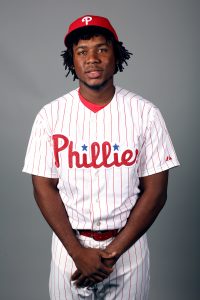

Maikel Franco, once the Phillies’ top prospect and a rookie on the brink of breaking out, was not the hitter fans wanted him to be in 2016. While his 25 home runs were a point of pride, his .255/.306/.427 slash line represented regression in all three categories. All of his hitting stats took a dip, and much of his 1.4 fWAR came from playing adequate defense.
Admittedly, it’s unfair and way too early to give up on the future slugger. He just finished his age-23 season, has acknowledged and alluded to working on his weak points, and had flashes of good hitting even last year (including his .347 wOBA in September and October). Plus, even last year he was still around league average in most offensive categories. If that’s rock bottom for him, there’s plenty of reason to believe in his future.
Still, a team with its eyes on the future will be closely monitoring the development of every player. This is especially true for a player as important to the lineup as Franco is and will continue to be.
Franco is a middle-of-the-order-type batter on a team with few others right now. Michael Saunders, who might be another, will be gone after a season or two. Tommy Joseph had a captivating 2016, but he still has to prove it wasn’t a fluke. Rising prospects like Rhys Hoskins, Dylan Cozens and Nick Williams have questions of their own to answer before they can flesh out the heart of the batting order. Consistent performance from Franco would do a lot, now and over the seasons to come, to solidify the middle of the order.
But if Franco does fall short – if he does top out as a mediocre hitter with okay defense – what then?
The options within the Phillies’ own system are sparse. Mitch Walding, a third baseman whose name once appeared on top-20 or -30 prospect lists for the club, hadn’t hit over .240 for a season of his five-year minor league career until 2016. Cole Stobbe is a legitimate third base prospect and potential well-rounded player but is years away from the majors. He might be penciled in for a 2020 debut, which would be too long to wait for contributions from third base.
The impending promotion of J.P. Crawford could give the Phillies the opportunity to shuffle the infield, moving Freddy Galvis to third base, but it’s difficult to imagine Galvis’ offense ever being better than Franco’s, even on their respective best and worst days.
Stat sheet archaeologists might have noticed that Tyler Goeddel played more than 900 innings at third base in high-A before he joined the Phillies. Converting back to third is unlikely at this point in his development, but it remains a longshot option for a guy with a certain amount of potential and enough competition for his current position. Regardless, there has been no indication that the Phillies have changed their plans for him.
In other words, an internal upgrade over Franco is unlikely. Even if he performs as a roughly average player, he’s ahead of the other candidates for at least the next few years.
Franco will have no competition at third over the next season or two, at which point an outside hire might be an option if the club is unhappy with his output. The front office has voiced its commitment to spending cash to upgrade the club, a philosophy that has been visible even for the coming season, when the team has no intentions of competing.
The question isn’t whether or not they’re willing to spend, it’s how much they’re willing to spend upgrading a position that is already performing just below average. Free agency is the chance to essentially buy wins, and it’s possible the team could spend at another position to better leverage their money into wins.
Human highlight reel Manny Machado will become available after the 2018 season and fits the bill as a mega-talented long-term upgrade over Franco, but he’ll come with an astronomical fee. The issue isn’t with his price tag – which he’s earned by being among the league’s most valuable third basemen since his 2012 debut – it’s with how funds are allocated. If outfield prospects are too slow to develop, the Phillies may focus on acquiring Bryce Harper that same offseason instead of upgrading over a third baseman who can tread water; if their pitching depth doesn’t develop a true ace or two, they may prefer to spend on Jake Arrieta after 2017, for example.
Even if they remain focused on a third baseman in 2018, Josh Donaldson is no slouch, either. He’ll be 33 at the time, though, and is only an option if the Phillies are searching for short-term solutions and immediate playoff runs. That may be the case, but the Phils will likely be at the beginning of their competitive window, instead seeking players who can stick around for a while.
The bottom line is that Franco might be the best option at third base regardless of how much he improves over last season. At his worst, he’s good enough that money can be better spent in positions of greater need; at his best, he could be an all-star caliber player and formidable presence in the middle of a batting order.
What shouldn’t get lost in consideration of alternatives is that Franco himself is a long way from washed up.
Remember: in his age-23 season, Mike Schmidt slashed .196/.324/.373. At 23, Chase Utley wasn’t in the majors yet. Utley also didn’t have an OPS+ over 100 until he was 26, a threshold Franco crossed easily when he was 22 when he reached a 130 OPS+. It’s unfair to expect any young player to match the careers of those two, but it’s equally unfair to give up on someone with so much talent when he’s still so young.